| Listing 1 - 10 of 35 | << page >> |
Sort by
|
Book
ISBN: 9780511271625 051127162X 9780511274039 0511274033 1107169534 1280815671 9786610815678 0511274785 051127548X 051127324X 0511320817 0511534795 051127243X Year: 2007 Publisher: Cambridge : Cambridge University Press,
Abstract | Keywords | Export | Availability | Bookmark
 Loading...
Loading...Choose an application
- Reference Manager
- EndNote
- RefWorks (Direct export to RefWorks)
This book was first published in 2007, a time of enormous change in the field of optical spectrometry. Although the basic optical principles remained unchanged, the design considerations were very different and, in many cases, more demanding. Developments in computer ray-tracing and computer-aided design coped with the extra impositions and allowed the construction of a new generation of spectrographs. The book covers the general principles of spectrographic design at the time, and the practical and engineering aspects of a broad range of spectrographs and spectrometers. The book deals with materials and methods of construction and includes suggestions for the choice of optical table, the design of slit mechanisms, and adjustable mirror, grating and lens mounts, with suggestions for the alignment and calibration of the finished instrument.
Spectrograph --- Spectrometer --- Spectrum analysis --- Astronomical instruments --- Astronomical photography --- Spectroscope --- Design and construction. --- Instruments

ISBN: 1281119113 9786611119119 0080548385 012374024X 9780123740243 9780080548388 9781281119117 6611119116 Year: 2007 Publisher: Amsterdam ; Oxford : Academic,
Abstract | Keywords | Export | Availability | Bookmark
 Loading...
Loading...Choose an application
- Reference Manager
- EndNote
- RefWorks (Direct export to RefWorks)
Chemometrics in Spectroscopy builds upon the statistical information covered in other books written by these leading authors in the field by providing a broader range of mathematics and progressing into the fundamentals of multivariate and experimental data analysis. Subjects covered in this work include: matrix algebra, analytic geometry, experimental design, calibration regression, linearity, design of collaborative laboratory studies, comparing analytical methods, noise analysis, use of derivatives, analytical accuracy, analysis of variance, and much more are all part of this chemome
Chemometrics. --- Spectrum analysis --- Statistical methods. --- Analysis, Spectrum --- Spectra --- Spectrochemical analysis --- Spectrochemistry --- Spectroscopy --- Chemistry, Analytic --- Mathematics --- Measurement --- Statistical methods --- Interferometry --- Optics --- Radiation --- Wave-motion, Theory of --- Absorption spectra --- Light --- Spectroscope --- Chemistry --- Qualitative --- Spectrometry --- Analytical chemistry
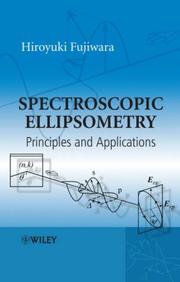
ISBN: 9780470016084 0470016086 Year: 2007 Publisher: Chichester Wiley
Abstract | Keywords | Export | Availability | Bookmark
 Loading...
Loading...Choose an application
- Reference Manager
- EndNote
- RefWorks (Direct export to RefWorks)
Ellipsometry --- Spectrum analysis --- Materials --- Optical properties --- Ellipsométrie --- Ellipsométrie --- Analysis, Spectrum --- Spectra --- Spectrochemical analysis --- Spectrochemistry --- Spectroscopy --- Chemistry, Analytic --- Interferometry --- Optics --- Radiation --- Wave-motion, Theory of --- Absorption spectra --- Light --- Spectroscope --- Engineering --- Engineering materials --- Industrial materials --- Engineering design --- Manufacturing processes --- Polarimetry --- Polarization (Light) --- Surfaces (Technology) --- Thin films --- Qualitative --- Analyse spectrale --- Spectrometry --- Analytical chemistry --- Materials - Optical properties
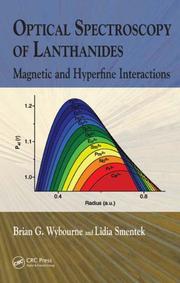
ISBN: 9781420006933 1420006932 9780849372643 084937264X 042912757X 1281065498 9786611065492 9780429127571 Year: 2007 Publisher: Boca Raton : CRC Press,
Abstract | Keywords | Export | Availability | Bookmark
 Loading...
Loading...Choose an application
- Reference Manager
- EndNote
- RefWorks (Direct export to RefWorks)
Rare earth metals --- Ions --- Spectrum analysis. --- Terres rares --- Analyse spectrale --- Spectra --- Spectra. --- Spectre --- Spectrum analysis --- 543.42 --- 546.654 --- 543.42 Spectrum analysis. Spectroscopy. Spectrography. Spectrometry. Spectrophotometry. Fluorescence analysis --- Spectrum analysis. Spectroscopy. Spectrography. Spectrometry. Spectrophotometry. Fluorescence analysis --- Analysis, Spectrum --- Spectrochemical analysis --- Spectrochemistry --- Spectroscopy --- Chemistry, Analytic --- Interferometry --- Optics --- Radiation --- Wave-motion, Theory of --- Absorption spectra --- Light --- Spectroscope --- Lanthanum La --- Qualitative --- Spectrometry --- Analytical chemistry
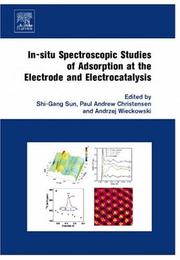
ISBN: 1281050997 9786611050993 0080489060 0444518703 9780444518705 9780080489063 Year: 2007 Publisher: Amsterdam ; Boston : Elsevier,
Abstract | Keywords | Export | Availability | Bookmark
 Loading...
Loading...Choose an application
- Reference Manager
- EndNote
- RefWorks (Direct export to RefWorks)
In-Situ Spectroscopic Studies of Adsorption at the Electrode and Electrocatalysis is a new reference on in-situ spectroscopic techniques/applications, fundamentals of electrocatalysis at molecule level, and progresses within electrochemical surface science. Presenting both essential background knowledge at graduate level and original research within the fields of spectroscopy, electrochemistry, and surface science. Featuring 15 chapters by prominent worldwide scholars, based on their recent progress in different aspects of in-situ spectroscopy studies, this book will appeal to a wi
Electrocatalysis. --- Electrodes. --- Adsorption. --- Spectrum analysis. --- Electrochemistry. --- Surface chemistry. --- Chemistry, Surface --- Interfaces, Chemistry of --- Surface phenomena --- Surfaces (Chemistry) --- Chemistry, Physical and theoretical --- Capillarity --- Surface energy --- Surface tension --- Surfaces (Physics) --- Analysis, Spectrum --- Spectra --- Spectrochemical analysis --- Spectrochemistry --- Spectrometry --- Spectroscopy --- Chemistry, Analytic --- Interferometry --- Optics --- Radiation --- Wave-motion, Theory of --- Absorption spectra --- Light --- Spectroscope --- Sorption --- Separation (Technology) --- Surface chemistry --- Electric resistors --- Catalysis --- Electrochemistry --- Qualitative --- Analytical chemistry

ISBN: 1280805005 9786610805006 038734120X 0387341196 Year: 2007 Publisher: New York, N.Y. : Springer,
Abstract | Keywords | Export | Availability | Bookmark
 Loading...
Loading...Choose an application
- Reference Manager
- EndNote
- RefWorks (Direct export to RefWorks)
Butterflies and Coleopterons are among the most colorful animals that we are lucky to observe. It is certainly not for our sake that nature indulges itself into such brightness, indeed this very beauty is vital. Although the present book is essentially the work of a physicist, its main objective is to be fundamentally trans-disciplinary. To understand the origins of those bright colors without looking at their evolution potential, to focus on the question "how" neglecting the question "why", would not only be unsatisfying, but it would also harm our understanding of the phenomena. The two aspects clarify one another and cannot be separated. This book can be read at various rhythms so that there is something in it for everyone. Biologists will find a clear and in-depth study of the different physical phenomena generating colors; that is all the things that we once learnt or which we often hear, but forgot. It will constitute a boundless "biomimetical" inspiration for physicists and engineers, for if physics is simple, the combinations of effects and the structures involved are extremely complex and original. As concerns students and teachers, this book will constitute a great base for practical works and it will finally fill with wonder those repelled by equations.
Insects --- Iridescence. --- Color. --- Interference (Light) --- Structural colors --- Hexapoda --- Insecta --- Pterygota --- Arthropoda --- Entomology --- Invertebrates. --- Classical Electrodynamics. --- Solid State Physics. --- Spectroscopy and Microscopy. --- Biological and Medical Physics, Biophysics. --- Invertebrata --- Animals --- Optics. --- Electrodynamics. --- Solid state physics. --- Spectroscopy. --- Microscopy. --- Biophysics. --- Biological physics. --- Physics --- Light --- Biological physics --- Biology --- Medical sciences --- Analysis, Microscopic --- Light microscopy --- Micrographic analysis --- Microscope and microscopy --- Microscopic analysis --- Optical microscopy --- Optics --- Analysis, Spectrum --- Spectra --- Spectrochemical analysis --- Spectrochemistry --- Spectrometry --- Spectroscopy --- Chemistry, Analytic --- Interferometry --- Radiation --- Wave-motion, Theory of --- Absorption spectra --- Spectroscope --- Solids --- Dynamics --- Qualitative --- Analytical chemistry

ISBN: 3540349332 3540241159 Year: 2007 Publisher: Berlin, Heidelberg : Springer Berlin Heidelberg : Imprint: Springer,
Abstract | Keywords | Export | Availability | Bookmark
 Loading...
Loading...Choose an application
- Reference Manager
- EndNote
- RefWorks (Direct export to RefWorks)
Learning Solid State Physics involves a certain degree of maturity, since it involves tying together diverse concepts from many areas of physics. The objective is to understand, in a basic way, how solid materials behave. To do this one needs both a good physical and mathematical background. One definition of Solid State Physics is it is the study of the physical (e.g. the electrical, dielectric, magnetic, elastic, and thermal) properties of solids in terms of basic physical laws. In one sense, Solid State Physics is more like chemistry than some other branches of physics because it focuses on common properties of large classes of materials. It is typical that Solid State Physics emphasizes how physics properties link to electronic structure. We have retained the term Solid State Physics, even though Condensed Matter Physics is more commonly used. Condensed Matter Physics includes liquids and non-crystalline solids such as glass, which we shall not discuss in detail. Modern Solid State Physics came of age in the late thirties and forties, and had its most extensive expansion with the development of the transistor, integrated circuits, and microelectronics. Most of microelectronics however is limited to the properties of inhomogeneously doped semiconductors. Solid State Physics includes many other areas of course; among the largest of these are ferromagnetic materials, and superconductors. Just a little less than half of all working physicists are in Condensed Matter. A course in Solid State Physics typically begins with three broad areas: (1) How and why atoms bind together to form solids, (2) Lattice Vibrations and Phonons, and (3) Electrons in Solids. One would then typically apply the above to (4) Interactions especially of electrons with phonons, (5) Metals, the Fermi Surface and Alloys, (6) Semiconductors, (7) Magnetism, (8) Superconductivity, (9) Dielectrics and Ferroelectrics, (10) Optical Properties, (11) Defects, and (12) Certain other modern topics such as layered materials, quantum Hall effect, mesoscopics, nanophysics, and soft condensed matter. In this book, we will consider all of these.
Solid state physics. --- Physics. --- Natural philosophy --- Philosophy, Natural --- Physical sciences --- Dynamics --- Physics --- Solids --- Condensed Matter Physics. --- Solid State Physics. --- Spectroscopy and Microscopy. --- Condensed matter. --- Spectroscopy. --- Microscopy. --- Analysis, Microscopic --- Light microscopy --- Micrographic analysis --- Microscope and microscopy --- Microscopic analysis --- Optical microscopy --- Optics --- Analysis, Spectrum --- Spectra --- Spectrochemical analysis --- Spectrochemistry --- Spectrometry --- Spectroscopy --- Chemistry, Analytic --- Interferometry --- Radiation --- Wave-motion, Theory of --- Absorption spectra --- Light --- Spectroscope --- Condensed materials --- Condensed media --- Condensed phase --- Materials, Condensed --- Media, Condensed --- Phase, Condensed --- Liquids --- Matter --- Qualitative --- Analytical chemistry --- Spectrum analysis.
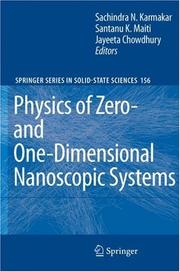
ISBN: 1281043753 9786611043759 3540726322 3540726314 3642091679 Year: 2007 Publisher: Berlin ; New York : Springer,
Abstract | Keywords | Export | Availability | Bookmark
 Loading...
Loading...Choose an application
- Reference Manager
- EndNote
- RefWorks (Direct export to RefWorks)
In recent years submicron and nanoscale systems have featured strongly on the research agenda due to the technological progress and new physics that have emerged from studies of ultra-small systems. A fundamental understanding of basic physical phenomena on the mesoscopic and nanoscopic scales is required to exploit the technological potential offered by these exotic materials. The present book contains review-like chapters by some of the leading experts in the field, covering topics such as the Kondo effect, electron transport, disorder and quantum coherence with electron-electron interaction, persistent current, thermoelectric phenomena, etc. in quantum dots, quantum wires, carbon nanotubes and more. This book will be valuable to researchers and students in condensed matter physics.
Nanoscience. --- Nanostructures. --- Nanotechnology. --- Molecular technology --- Nanoscale technology --- High technology --- Nanoscience --- Physics --- Nano science --- Nanoscale science --- Nanosciences --- Science --- Quantum theory. --- Quantum Physics. --- Solid State Physics. --- Spectroscopy and Microscopy. --- Quantum dynamics --- Quantum mechanics --- Quantum physics --- Mechanics --- Thermodynamics --- Quantum physics. --- Solid state physics. --- Spectroscopy. --- Microscopy. --- Analysis, Microscopic --- Light microscopy --- Micrographic analysis --- Microscope and microscopy --- Microscopic analysis --- Optical microscopy --- Optics --- Analysis, Spectrum --- Spectra --- Spectrochemical analysis --- Spectrochemistry --- Spectrometry --- Spectroscopy --- Chemistry, Analytic --- Interferometry --- Radiation --- Wave-motion, Theory of --- Absorption spectra --- Light --- Spectroscope --- Solids --- Qualitative --- Analytical chemistry
Book
ISBN: 9783540302797 Year: 2007 Publisher: Berlin ; New York : Springer,
Abstract | Keywords | Export | Availability | Bookmark
 Loading...
Loading...Choose an application
- Reference Manager
- EndNote
- RefWorks (Direct export to RefWorks)
This book is a blend of analytical methods based on the phenomenon of atomic and nuclear physics. It comprises comprehensive presentations about X-ray Fluorescence (XRF), Mössbauer Spectroscopy (MS), X-ray Photoelectron Spectroscopy (XPS), Neutron- Activation Analysis (NAA), Particle Induced X-ray Emission Analysis (PIXE), Rutherford Backscattering Analysis (RBS), Elastic Recoil Detection (ERD), Nuclear Reaction Analysis (NRA), Particle Induced Gamma-ray Emission Analysis (PIGE), and Accelerator Mass Spectrometry (AMS). These techniques are commonly applied in the fields of medicine, biology, environmental studies, archaeology or geology et al. and pursued in major international research laboratories.
nuclear physics --- Plasma physics --- Electromagnetism. Ferromagnetism --- Chemical technology --- materiaalkennis --- elektromagnetisme --- Atomic physics --- meetmethoden --- plasmafysica --- Analytical chemistry --- lasers (technologie) --- Materials sciences --- Nuclear physics --- analytische chemie --- Measuring methods in physics --- fysica --- Solid state physics --- Spectrum analysis. --- Particles (Nuclear physics) --- Partículas (Física nuclear) --- FISICA --- Elementary particles (Physics) --- High energy physics --- Nuclear particles --- Nucleons --- Analysis, Spectrum --- Spectra --- Spectrochemical analysis --- Spectrochemistry --- Spectroscopy --- Chemistry, Analytic --- Interferometry --- Optics --- Radiation --- Wave-motion, Theory of --- Absorption spectra --- Light --- Spectroscope --- Qualitative --- Spectrometry
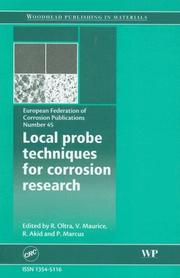
ISBN: 1845692594 1845692365 9781845692599 9781845692360 9781420054057 Year: 2007 Publisher: Woodhead Publishing
Abstract | Keywords | Export | Availability | Bookmark
 Loading...
Loading...Choose an application
- Reference Manager
- EndNote
- RefWorks (Direct export to RefWorks)
The effective investigation of corrosion requires the use of methods that can probe material surfaces at the atomic or molecular level and can be used in situ. This important collection reviews the range of techniques available and how they can be used to analyse different types of corrosion.A number of chapters discuss the use of scanning probe microscopy techniques such as electrochemical scanning tunnelling microscopy and atomic force microscopy (EC-STM and EC-AFM). Other chapters analyse local electrochemical techniques such as scanning electrochemical microscopy (SECM), scanning v
Corrosion and anti-corrosives. --- Scanning probe microscopy. --- Spectrum analysis. --- Analysis, Spectrum --- Spectra --- Spectrochemical analysis --- Spectrochemistry --- Spectrometry --- Spectroscopy --- Chemistry, Analytic --- Interferometry --- Optics --- Radiation --- Wave-motion, Theory of --- Absorption spectra --- Light --- Spectroscope --- Scanned probe microscopy --- Scanning electron microscopy --- Anti-corrosive paint --- Atmospheric corrosion --- Metal corrosion --- Metals --- Rust --- Rustless coatings --- Chemical inhibitors --- Chemistry, Technical --- Fouling --- Materials --- Weathering --- Paint --- Protective coatings --- Waterproofing --- Qualitative --- Corrosion --- Deterioration --- Surfaces --- Material Science and Metallurgy --- General and Others --- Analytical chemistry
| Listing 1 - 10 of 35 | << page >> |
Sort by
|

 Search
Search Feedback
Feedback About UniCat
About UniCat  Help
Help News
News